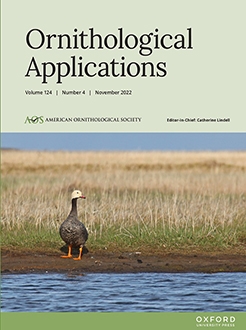Populations of avian aerial insectivores have declined across North America. A leading factor hypothesized to be driving these trends is a decline in prey populations, although a loss of suitable habitat on the landscape or other factors may also play a role. The Eastern Whip-poor-will (Antrostomus vociferus; hereafter: whip-poor-will) is an aerial insectivorous nightjar that has disappeared from many of its historic breeding locations. We investigated the role that food availability and land cover at multiple scales play in whip-poor-will distribution by estimating their abundance at 23 sites across central Illinois. To do this, we conducted nocturnal point counts to estimate whip-poor-will abundance and collected nocturnal insects using UV-light traps at these sites to quantify potential food abundance. Additionally, we described whip-poor-will diet using DNA metabarcoding of fecal samples. We found that the number of large moths at a site had a positive effect on the abundance of whip-poor-wills, aligning with our diet analysis which identified moths as the primary prey item for this species (present in 92% of samples). Whip-poor-wills also showed an affinity for forest edges, but only when edges were associated with high moth abundances. Conversely, developed land-cover in landscapes surrounding sites led to decreased whip-poor-will abundance. Given the continued expansion of developed areas, coupled with concerning trends in moth populations, declines in the abundance of this species may continue. Efforts should be made to protect and sustain moth populations and the impacts of development should be scrutinized in the pursuit of conserving whip-poor-wills.
LAY SUMMARY
Declines in aerial insectivores, like the Eastern Whip-poor-will, may be driven by reduced insect populations and/or by changes to habitat.
We described the diet of Eastern Whip-poor-wills in Illinois and modeled their abundance to determine which factors influence their distribution.
Eastern Whip-poor-will diet was primarily composed of moths and whip-poor-will abundance was greater in areas with more moths.
Urbanization had a negative impact on the abundance of the Eastern Whip-poor-will.
Sustaining moth populations and considering the effects of development are necessary for conserving Eastern Whip-poor-wills.
Las poblaciones de aves insectívoras aéreas han disminuido en América del Norte. Se supone que un factor principal que impulsa estas tendencias es la disminución de las poblaciones de presas, aunque la pérdida de un hábitat adecuado en el paisaje u otros factores también pueden jugar un rol. Antrostomusvociferuses es un atajacaminos insectívoro aéreo que ha desaparecido de muchos de sus lugares históricos de reproducción. Investigamos el papel que juegan la disponibilidad de alimentos y la cobertura del suelo en múltiples escalas en la distribución de A. vociferuses mediante la estimación de su abundancia en 23 sitios en el centro de Illinois. Para hacer esto, llevamos a cabo conteos de puntos nocturnos para estimar la abundancia de A. vociferuses y recolectamos insectos nocturnos usando trampas de luz ultravioleta en estos sitios para cuantificar la abundancia potencial de alimento. Además, describimos la dieta de A. vociferuses usando meta codificación de barra de ADN de muestras fecales. Encontramos que la cantidad de polillas grandes en un sitio tuvo un efecto positivo en la abundancia de A. vociferuses, lo que concuerda con nuestro análisis de la dieta que identificó a las polillas como la principal presa de esta especie (presente en el 92% de las muestras). A. vociferuses también mostró afinidad por los bordes de bosque, pero solo cuando los bordes estaban asociados con una gran abundancia de polillas. Por el contrario, la cobertura del suelo con desarrollo en los paisajes que rodean a los sitios condujo a una disminución de la abundancia de A. vociferuses. Dada la continua expansión de las áreas desarrolladas, junto con tendencias preocupantes en las poblaciones de polillas, la disminución en la abundancia de esta especie puede continuar. Se deben hacer esfuerzos para proteger y sostener las poblaciones de polillas y se deben examinar los impactos del desarrollo en los intentos de conservación de A. vociferuses.






